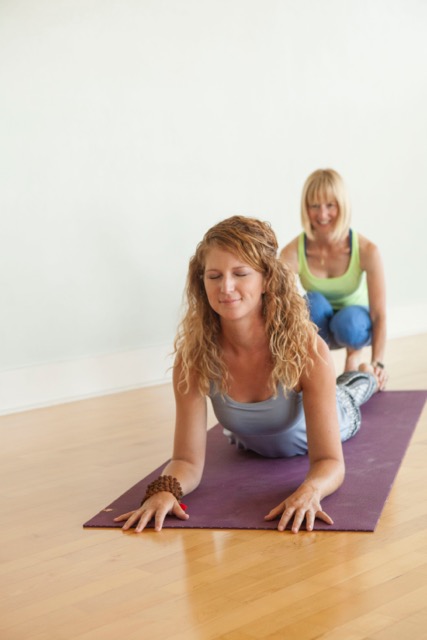Yin is In!
Yin Yoga: The Quieter, Deeper Practice
by Shauna MacKay, BPE, C-IAYT, E-RYT
The first time I took a Yin class it was not what I expected. I’d assumed it would be like a restorative class, where I would be relaxing over bolsters, allowing the props to support me, as the tension released from my body. Instead, I found myself riding the edge of sensation, in a long held lunge, wondering when it would end!
It was sometime later, that I practiced with Yin Master, Bernie Clark, and experienced a deep opening in both my body and mind. I now realize that understanding the basics of Yin Yoga prior to taking a class can make a big difference in the effectiveness and enjoyment of the class. So here are the answers to some common questions I am asked about Yin Yoga.

What is Yin Yoga?
Yin Yoga is a slow-pace style of yoga where the poses are held for longer periods of time (1 – 5 minutes). Believed to stretch and stimulate the deep connective “yin” tissues of the body, it’s a highly effective way to open the body and still the mind.
How is it different than other styles of Yoga?
Most styles of yoga are yang in comparison, meaning more active, engaging the yang muscle tissues. Generally, muscles like rhythmic, repetitive, short duration movement. Yin Yoga, on the other hand, brings the body into a soft, less muscular shapes and through long holds, releases tension in fascia, tendons and ligaments or more yin tissues of the body.
What are the benefits of Yin Yoga?
Yin works on the physical, energetic and mental bodies. It can improve flexibility, sometimes substantially as the targeted fascia and other yin tissues begin to soften and release their holding patterns.
Emerging from innovative teachers like Paul Grilley and Paulie Zink, Yin Yoga integrates elements of Chinese medicine, in particular, the theory of energetic meridians. Acupressure and acupuncture are common healing techniques utilizing the knowledge of meridians. Similarly, a Yin practice is meant to stimulate energy or the flow of Chi through the body.
Yin poses are held 1 – 5 minutes. Each pose is like a mini meditation session. It’s a chance to settle in and be still. A skilled teacher will support you in your finding your own method of cultivating peace within the poses.


Who should practice Yin Yoga?
Almost anyone can get value from a regular Yin practice. Yin addresses physical, emotional and spiritual needs. Physically, those who have tight, inflexible or strong athletic bodies can benefit from the slow, mindful approach to releasing tension in the body. Emotionally, it can be a calming practice, particularly to those who find meditation difficult. And the spiritual benefits of a quiet, introspective practice may translate into a more peaceful outlook in everyday life.
Personally, Yin Yoga has helped quiet my mind, improve my flexibility and open my heart. As my teacher Bernie Clark taught, “In Yin Yoga, we use the pose to get into the body, rather than the body to get into the pose.”
Join Shauna on Wednesday mornings, 7:45-8:45 AM for Yin Yoga.
